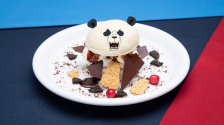Join Scott for a very special conversation with Japan’s pop culture uber-geek and author Matt Alt as they discuss his work with Bandai, and talk Gundam and other giant robots, Pokemon, anime in general, how Japanese toys saved the country after WWII, and of course Matt’s just-published new book Pure Invention which explains how all this fun stuff “conquered the world!”
Pick up a copy of “Pure Invention” right here!





Castoff20
This has been such an interesting watch, really good to have Matt Alt tell us so much about how Japanese pop culture spread outside its home country, what a wealth of information he is! I really need to pick up a copy of that Pure Invention book (or maybe I’ll win one? Fingers crossed haha!), from what I’ve heard so far just from this video, it’ll be an absolutely amazing read!!
kris Roy
Excellent show my own route to Japanese culture was similar to both Matt and Scott and living in Scotland in the 70’s and 80’s many products like Gunpla where a revelation to me, Not being as immersed it was insightful to listen to there knowledge and experiences of the culture first hand look forward to reading Matts book and building more Gunpla not at the same time.
MightyLeg
I think the hg kits are towards the younger folks
Mild Sauce
there more love to the mechs more than their pilots
ZA
Really interesting stuff!
One thing worth noting IRT the general reticence found in Japanese super hero stories (such as Gundam) is that it came about not merely as a reaction from the loss of WW2 but also as a reaction against a resurgent nationalism. Yoshiyuki Tomino and other artists (including Tadao Nagahama, who’s earlier Voltes 5 presages Gundam to an extent) were purposely pushing back against a revisionist sentiment.
xxnike629xx
Interesting insight on how you went about doing all of this.
Really though it’s about being at the right time at the right place.
I agree that newer GunPla kits are more accessible; when years ago you had to be more involved to be able to build kits and I think that aspect was a turn off for so many people because of how involved the kits were before.
Oh man I love how back in the 1990s, catalogs were a thing and as kids back then, we didn’t have things like the Internet so all we had were these magazines.
I wasn’t aware that Japanese toy companies was what helped Japan so much outside of World War II.
That is cool that the Walkman and Discman
However, I guess many people (especially younger people these days) can’t really realize how involved ‘nerd’ content people were into.
That is interesting that Japanese culture is a story looked at from the perspective from the losing aspect, It makes sense if you think about it.
CES06
Great talk, I’ve been following the discussions about the book and each one makes me want to read it even more!
(Hope I get lucky!)
I really like Matt’s observation about how the way we create things has been so influenced by Japanese sensibilities- media & content-creation wise, it feels absolutely true! I know the book focuses more on the physical goods side of things but with media & content such as illustration, comic books, video games, and animation, I feel like the extent of just how widespread & rooted Japanese ideas are is even more profound.
Pokemon GO is a great example, but also things like Avatar: the Last Airbender, Castlevania, & pretty much the emerging animation industry in China, they’re all very much inspired by Japanese visual sensibilities. There’s a whole new generation worldwide who grew up on Japanese inventions that are becoming creators in their own right that probably don’t even realize the Japanese roots of how they make things, and that just goes to show how much Japan’s pop culture “conquered” the world in that part.
Anna
It’s really true when you think about it, isn’t it? There are so many concepts and tropes, even, in mainstream media and entertainment that seem to have stemmed from Japanese influence. One small example that stands out to me is the use of “sweatdrops” in modern animated series to show characters’ exasperation or embarrassment. I remember it was novel to see that in anime in the late ’90s, because it wasn’t something you saw in Western animation, but now that’s changed!
sakuP
If it isn’t already in the book, I’d like to see someone cover the culture of personalisation in Otaku culture. There’s just something very Japanese about being mad good at homebrew crafting and customising everything from clothes to plamo to figures at crazy good levels. It’s interesting to see how that kind of culture (that powers wonfes, comiket etc) starting to inform toy product design even more than before now as Japanese goods like plamo are part of global mainstream consumption.